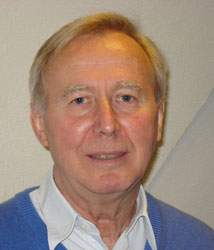
Dr. Thijs de Graauw
The ALMA Board has announced that Dr. Thijs de Graauw of the Netherlands has been appointed Director of the Atacama Large Millimeter/sub-millimeter Array (ALMA). Dr. de Graauw's appointment follows a search by an international committee.
Dr. de Graauw is a world expert in infrared and sub-millimeter astronomy. He has considerable experience in coordinating and leading large international scientific projects. In particular, he was the Principal Investigator of the successful Short Wavelength Spectrometer that flew on the Infrared Space Observatory (ISO) and is currently the Principal Investigator of the Heterodyne Instrument for the Far-Infrared (HIFI) on the Herschel Satellite which is to be launched in 2009.
Dr. de Graauw has been serving as Interim ALMA Director since April 1, 2008. Before joining ALMA, he was a professor at Leiden University. At the Netherlands Institute for Space Research (SRON), he was responsible for the infrared and sub-millimeter research program.
The ALMA Director has announced that Dr. Richard Kurz has been appointed Project Manager of the Atacama Large Millimeter/sub-millimeter Array (ALMA) in the Joint ALMA Observatory (JAO) effective November 1, 2008. Dr. Kurz's appointment follows a search by an international committee.
Dr. Kurz has extensive management experience in space and astronomical projects. He has been serving as Interim European Project Manager since February 2008. From 1999 to 2004, Dr. Kurz was ALMA European Project Manager at the European Organisation for Astronomical Research in the Southern Hemisphere (ESO) in Germany. At ESO, he organized the European side of the ALMA collaboration. Dr. Kurz was Project Manager of the Gemini 8-Meter Telescopes and, before that, managed a variety of NASA and Department of Defense space programs while at TRW Space and Defense and NASA.
Dr. Kurz holds a Ph.D. in Physics from the University of California at Berkeley. He has published many scientific and technical papers on high-energy elementary particle physics and presented ALMA at international conferences throughout the last decade.
Additionally. Dr. Tetsuo Hasegawa has been appointed Deputy JAO Project Manager of the Atacama Large Millimeter/submillimeter Array (ALMA) effective November 1, 2008. Dr. Hasegawa's appointment follows a search by an international committee.
Dr. Hasegawa has considerable experience in management of astronomical projects, as well as a distinguished academic career. He has been serving as JAO Interim Project Manager since May 2008. Before coming to Chile, Dr. Hasegawa was JAO Project Director and Project Manager at the National Astronomical Observatory of Japan. Dr. Hasegawa holds a Ph.D. in Science from the University of Tokyo, where he taught at the Institute of Astronomy (1988-2000) and Nobeyama Radio Observatory (1980-1988). He specialized in interstellar medium physics and has published extensively on this and other topics.
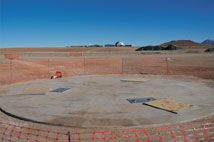
Figure 1. A concrete AOS antenna foundation cures. Cerro Chico is in the right foreground. Photo by Patricio Pardo.
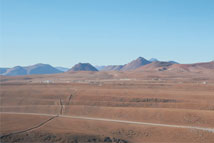
Figure 2. The view toward the array center from Cerro Chico. The Technical Buildings are to the left; the Cosmic Background Imager facility is to the right. Photo by A. Beelen.
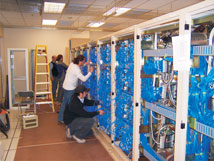
Figure 3. One thousand three hundred cables have been installed in the first correlator quadrant in its oxygenated AOS technical building home. Automated software detected two interchanged cables, which were quickly corrected.
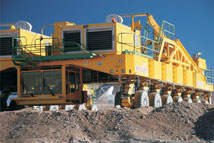
Figure 4. One of two massive ALMA transporters undergoes tests at the 16,500 foot Array Operations Site. The APEX antenna, which is similar to the Vertex prototype antenna, can be seen through the undercarriage. Photo by A. Beelen.

Figure 5. Raster scanned images of the Moon were made with the prototype antennas and imaged with CASA software: Vertex antenna image (right), Alcatel antenna image (left). Emission is entirely thermal, probing the temperature just below the surface; there is some thermal lag. For these reasons, the Moon's millimeter-wave appearance is quite different from its appearance at optical wavelengths. The Moon phase was a few days from first quarter.
Concrete has been received and poured for twenty-five antenna foundations at the 16,500 foot altitude AOS. This number will nearly double by the end of the year.
The first quadrant of the bilateral correlator, which can serve 32 antenna stations, is being wired for duty at the AOS Technical Building. Thirteen hundred cables have been installed and tested in the oxygenated correlator room of the building. Tests continue on schedule. In Charlottesville, the second quadrant is being used for testing while the third quadrant is being assembled.
Elements of the Calibration Device were installed on the Front End and tested as the first receiver package was readied for installation on the Mitsubishi Electric Company antenna No 2, which is undergoing acceptance testing. Operation of elements of the ALMA Back End, installed on that antenna, was demonstrated from the temporary integration facility. Acceptance tests, pointing in particular, were carried out on the first two Vertex antennas. The first of these is progressing through its acceptance tests. Elements of the seventh Vertex antenna arrived at the OSF, bringing the number of antennas on site to eleven. An area is being prepared for the European antenna, elements of which should be shipped before the end of the year.
The ALMA Test Facility underwent a maintenance period during September. Software testing will resume in October. During August, interferometric monitoring of calibrator fluxes was demonstrated, including reduction of the data, with good results. The first tests of the production antennas in Chile will be as single entities; a program of single antenna testing concluded with a demonstration of planet tracking and raster imaging. Raster scans of the moon were made with each of the two antennas, then the data were massaged into images with the CASA software (Figure 5).
About two dozen astronomers gathered September 8 - 10 in Grenoble for discussions about ALMA simulations, sharing experiences, ideas, and algorithms. Simulation of ALMA science targets illustrated the power of ALMA in a number of scientific fields, from debris disks to distant galaxies. Interactions at the meeting are expected to hone simulations to guide development of calibration strategies, observing modes and other elements for optimization of observing with ALMA.